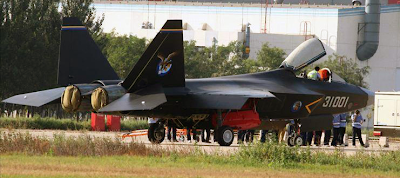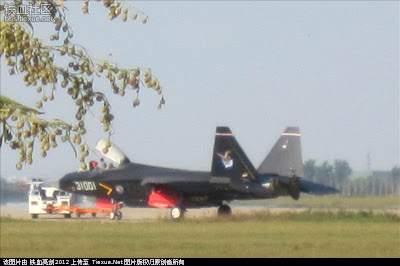 |
| China's J-31 Stealth Fighter Jet |
China's Sheyang Aircraft Corporation(SAC) one of the leading aircraft
design and manufacturing corporations of China’s aviation industry and
a competitor of Chengdu Aircraft Corporation(CAC) Which is the maker
of china's first low observable or stealth Fighter J-20 Black Eagle
has Unveils its J-31 or J-21 Stealth Fighter Through leaking the
images of J-21 or J-31 on internet.
 |
| China's J-31 Stealth Fighter Jet |
The numerous images of the J-31 or J-21 show that the aircraft is very
different from the large, canard-delta J-20 Black Eagle. The Shenyang
fighter appears to be much smaller than the J-20, with about two-
thirds as much installed power. It is a quad-tail design with a
moderately swept clipped-delta wing and large canted vertical tails,
with a similar overall layout to the Lockheed Martin F-22—but more
like the F-35A Joint Strike Fighter in terms of overall size. Weapon
bays occupy the entire lower body aft of the inlets and ahead of the
engine bays. Flight controls are conventional, with separate rudders
and single-piece flaperons.
As in the case of the J-20 Black Eagle, most of the stealth-shaping
techniques are very similar to those on Lockheed Martin fighters, but
the engine nozzles are conventional. The nozzle shape on the prototype
is close to that of the Guizhou WS-13 or Klimov RD-93 engine which is
install on the Chengdu JF-17 fighter, minus the tapered “collar” that
fairs the latter's nozzle into the aft fuselage. Thrust vectoring has
been studied in China but has not yet been demonstrated in flight.
 |
| China's J-31 Stealth Fighter Jet |
One common feature of the J-20 and J-31 is that both, from images seen
to date, appear to be beyond an “X-plane” stage. Both are equipped
with weapon bays; both are full-scale demonstrators, and neither
appears to use any components of existing aircraft. However, the
timing of the development of operational variants and full-scale
production remains uncertain. China is continuing the development of
conventional non-stealthy fighters, and it remains to be seen when
industry there can start producing competitive domestic engines and
break the nation's dependency on imported Russian power. (So far, all
production JF-17s have been RD-93-powered although a Chinese
replacement, the Guizhou WS-13, is under development.)
The J-31 bears a resemblance to Lockheed Martin’s F-35, and even
reportedly has the codename F-60. Though absolutely no characteristics
of the prototype have been unveiled, one major difference is obvious:
unlike its American relative, China’s F-60 has two engines.




No comments:
Post a Comment